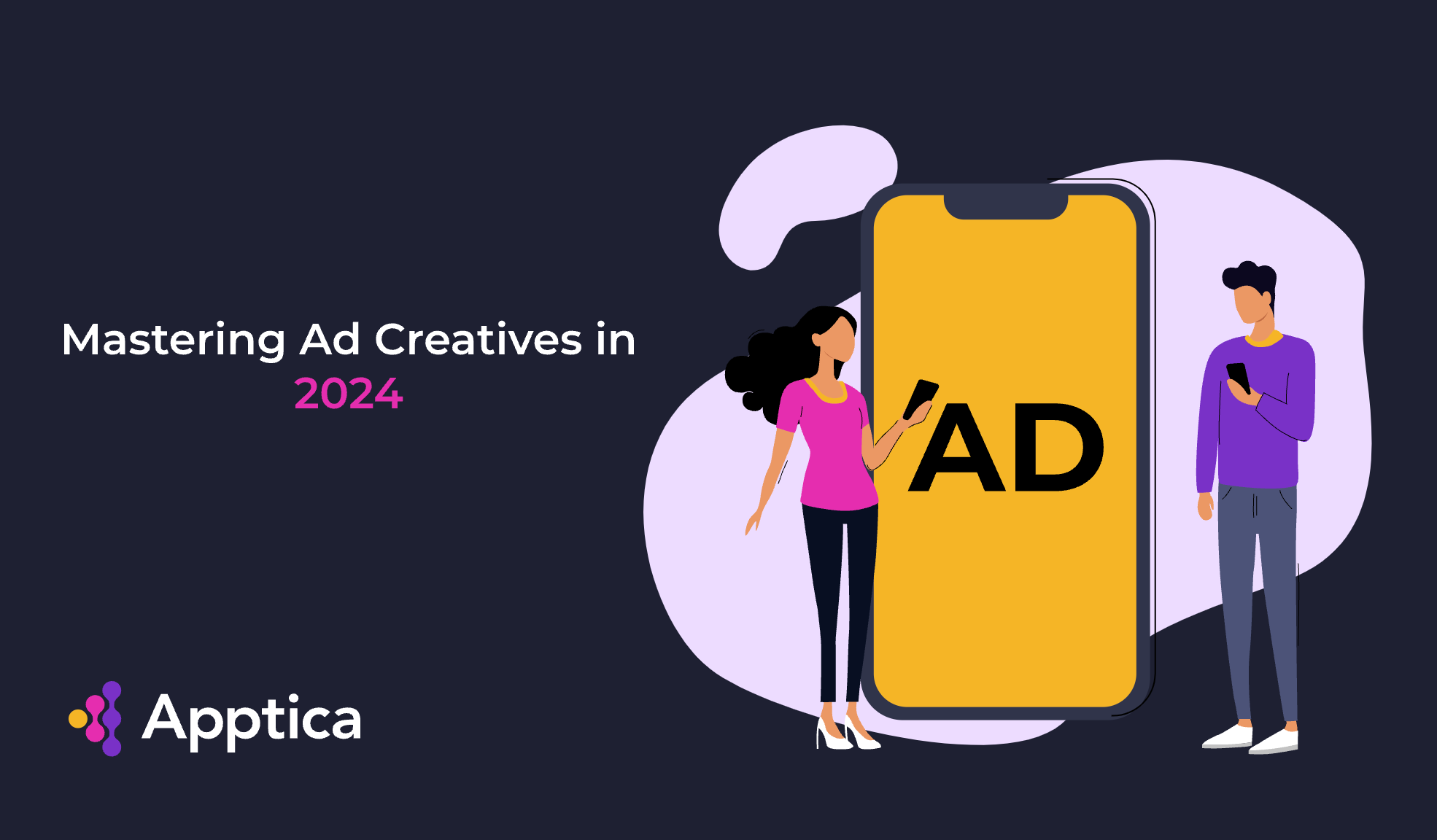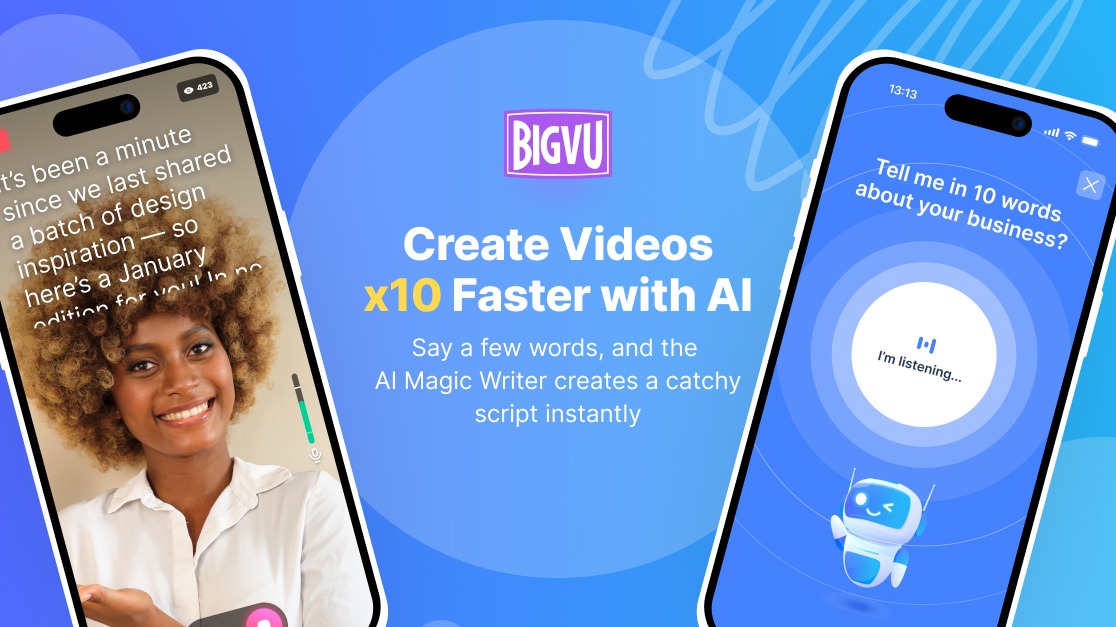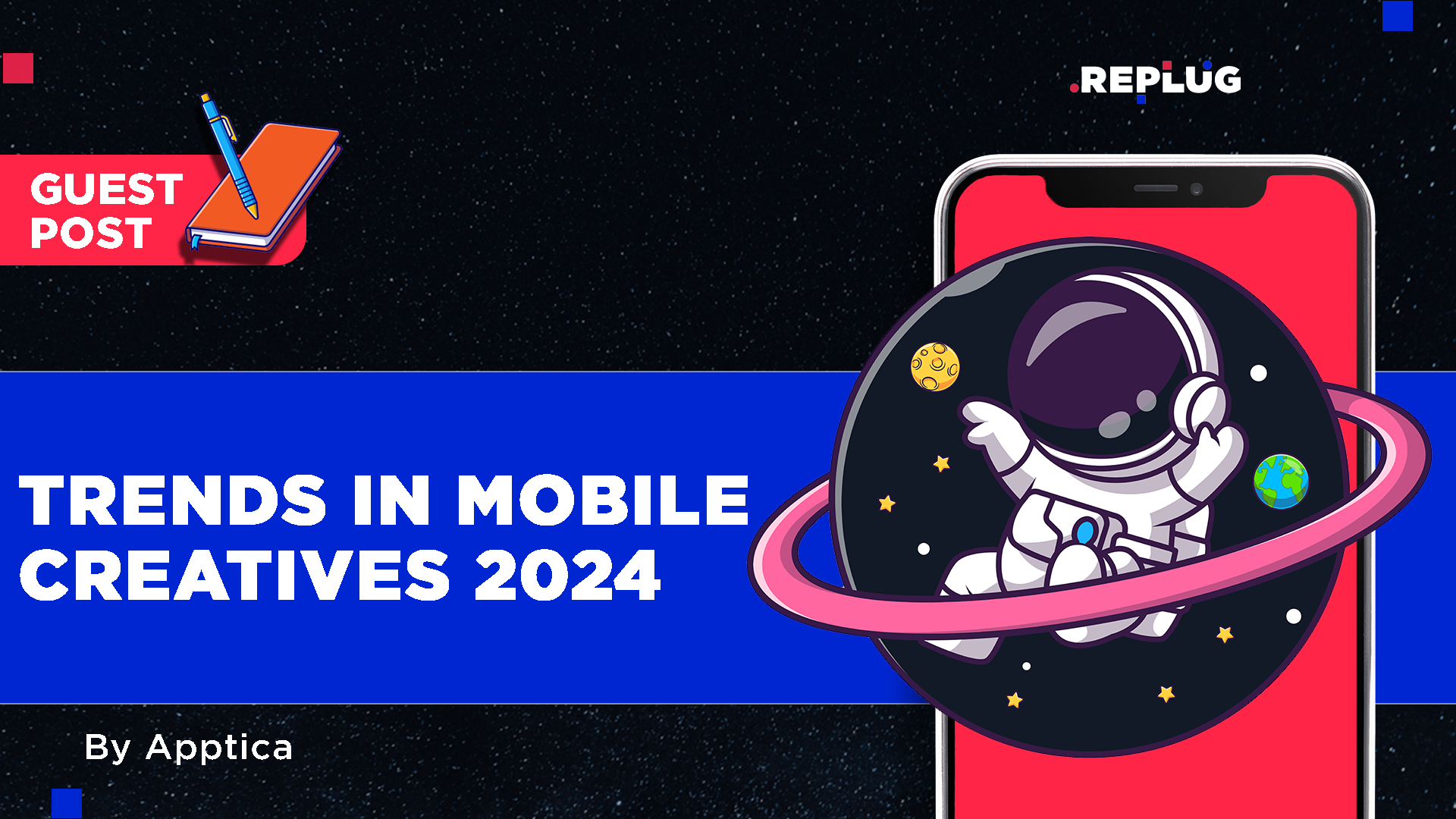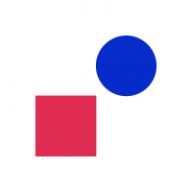Mastering Ad Creatives in 2024
Find out the recent stats on creatives, working mechanics, proven design tips, recommendations for optimization and much more.

Advertising techniques evolve, and creatives are no exception. Captivating media lose their power over time, so it’s a great idea to refresh your knowledge about what’s trendy. By implementing the approaches we’ve prepared, you can improve the performance of your campaigns.
Specifically, we’ll refresh your knowledge about mobile and in-app advertising, go through the mobile market creatives, and explore the top apps of 2024, as well as the media they use for user acquisition. Scroll down to learn more about how to upgrade your digital ads in 2024.
Mobile Ads Crash Course
Specializing in mobile analytics, we’ll focus on mobile app ads specifically. Mobile traffic makes up almost 60% of the market, and its share keeps on growing.
Understanding the most popular ad dimensions and their distribution can significantly enhance the effectiveness of advertising campaigns. The most popular dimensions for ads are 320 x 72 for banners, 360 x 640 for videos, and 320 x 640 for playables. The ratio distribution shows that banner sizes are more evenly spread across different dimensions, while videos have a significant preference for 360 x 640, and playables are dominated by 320 x 640 with a high ratio.
Trends indicate that banners prefer diverse sizes, reflecting varied platform use, whereas videos and playables concentrate on specific dimensions for better performance. For marketers and advertisers, it is recommended to use a variety of banner sizes to cover different platforms, focus on 360 x 640 and 720 x 1280 for videos to achieve optimal results, and prioritize 320 x 640 for playables to ensure the best engagement. Here are the graphs for the ratio distribution of different formats and sizes of mobile ads:



There's one more crucial thing for advertisers to optimize their content for maximum engagement and effectiveness – understanding of the duration metrics. The charts below with the durations of video and playable advertisements were collected from January 1st to June 1st, 2024.


The visuals illustrate that the "Video Duration" chart shows a clear preference for 30-second ads, with 15-second ads being the next most common. Other durations like 29, 26, and 25 seconds are significantly less frequent, indicating a trend towards standardized ad lengths.
The "Playable Duration" chart also highlights a strong preference for 30-second ads, followed by 45-second ads. The dominance of the 30-second format in both video and playable ads suggests it is the optimal length for capturing audience attention and delivering content efficiently.
Understanding mobile ad formats and sizes helps to design converting creatives. A higher conversion rate (CR) improves app performance and monetization.
Converting Creatives Explained
Increasing CR is relatively easy, but requires time, dedication, and discipline. Follow the steps below to improve the quality of your ads.
It’s Personal Now
Imagine you're baking cookies (the other kind), and you have different friends coming over. Some like chocolate chips, others prefer raisins, and some even want nuts! You wouldn't bake the same cookies for everyone, right? That's just like personalized ads! Personalization starts with 5 steps:
- Understand the audience: learn what kind of cookies your friends prefer.
- Data-driven insights: use our mobile analytics for field-tested and complete information, like individual location, purchasing behavior, age, gender, etc. Pay attention to when the audience stays online and which social media channels they prefer.
- Segmentation: gingerbread is not everyone’s cup of tea, so group the people, based on our mobile app traffic analysis and deliver the right content at the right time. Pay close attention to local time zones and start with broad targeting settings, before narrowing down.
- Personalized content: once you understand the audience and segment it, start making tailored ads to increase your sales (installs) by up to 20%. This can range from changing the people in the creative to adjusting the funnel flow by adding pre-landers for a more seamless UX.
Michael Corleone said: “Nothing personal, just business” — we say: “Marketing business is all about being personal”.
Fake It Till You Make It
Spy tools can serve a good and bad cause. Besides blind copy-pasting, you can use such instruments to explore a new vertical or learn the latest insights about which creatives enjoy the most impressions, clicks, and CTR rates. Our ad intelligence and app analytics tool keeps you up to date with the latest trends, provides insights on what the competitors are doing, and suggests the best creatives to achieve your goals.
One Step at a Time
A single creative for a single idea. Adding extra messages can confuse the user, and if they have to think hard about what you’re selling, they’ll quit. Top apps might have a few selling points, but you have to pick just one and capitalize on it. Use other creatives, if you want to highlight other features.
A Framework for How to Segment
Via: GrowthMarketer
According to Eugene Schwartz, there are 5 stages of customer awareness, crucial for effective copywriting and advertising:
- Unawareness: prospects in this stage are unaware of the problem or need they have. Marketing content at this stage aims to lead them into recognizing their problem or desire.
- Problem awareness: at this stage, prospects realize they have a problem but are unaware of the solutions available. Copywriting here focuses on highlighting the problem and building a desire for a solution.
- Solution awareness: prospects in this stage are aware of the problem and are actively seeking solutions. Copywriting emphasizes the solution, but not necessarily your specific product.
- Product awareness: at this point, prospects are researching various products or services to solve their problem, including yours. Marketing content needs to provide specifics about your product, its features, benefits, and pricing.
- Most awareness: prospects are ready to make a decision and buy, but may need a final push or clarification. Copywriting here is simple and direct, often featuring a clear call-to-action (CTA).
Your single funnel is bound to involve at least some of these stages. Thus, make sure you gradually introduce your solution to the user, without jumping to the conclusion. But this framework is applicable for lead generation too, since user acquisition involves various segments, some of which might already be familiar with your product.
Consistency Throughout the Funnel
From the first impression to the install page, your funnel elements are to synergize. This is especially true for eCommerce, where focusing on just a single product throughout the campaign delivers better results. Gradually develop your story from the very first ad, using the framework from the section above.
Your funnel must command no objections by delivering a seamless experience. It goes beyond just colors and flashy CTAs. You need to tell a complete story, involving:
- Hero, sharing their personal history
- Challenge, or difficulty, in need of resolution
- Guide, directing the individual toward a remedy
- Answer, effectively resolving the challenge
- Result, encompassing feelings, suggestions, and contemplations
Skipping from Hero to Result won’t cut it, as the user won’t feel any emotional attachment and involvement. As we’ve said in the beginning, be patient and consistent.
Tips on Design
Even if there are best practices for an ad’s anatomy, there isn't a one-size-fits-all formula. The key to making the best practices mentioned above, the best they can be, lies in understanding your audience and speaking their language.
User-centric creativity is crucial as it ensures that the content resonates deeply with your audience, addressing their specific challenges, preferences, and cultural nuances. You can create a more meaningful connection and drive better results by tailoring your ads to your audience's needs.
This is the exact reason why Admiral Media always analyzes the broader perspective of our client's offerings and audience(s) before we build any creatives or campaigns.
Each of the tips provided in the previous section aims to enhance the connection between your ad and its viewers by addressing their specific challenges, preferences, and culture to offer relatable solutions. Below, you can see a few examples of how the same brand can speak to different audiences with eye-catching visuals, captivating headlines, clarity, and value proposition highlights customized to their profiles.
So, while creative best practices provide a foundation, the best approach is to deeply understand your audience’s language and needs. By doing so, you can produce ads that are not only visually and textually compelling, but also genuinely resonant and effective in addressing the goals and desires of your target market. Working with performance marketing for many years, we’ve observed the changes in the targeting options on the ad networks - and one thing is sure: creatives have become a significant part of doing the targeting.
Leverage ‘Laswell’s communication model’
Models like these are rarely mentioned in articles. However, they are crucial for gaining a better understanding of how you are going to communicate to your audience. Improved creatives lead to greater opportunities for enhanced performance. Laswell’s model breaks down the communication process into five key components:
Here’s how this model can be applied in targeting, and still, with privacy in mind:
- Who (communicator): Define your brand’s voice to align with your audience's expectations – authoritative, friendly, or informative.
- Says what (message): Your message should speak directly to your audience's needs, pain points, and aspirations.
- In which channel (medium): Choose channels that your audience frequents, be it social media, email, programmatic or through web-to-app campaigns.
- To whom (audience): Tailor your messages to the segmented audience groups, ensuring relevance and personalization.
- With what effect (outcome): Be clear about the desired result, whether it's raising awareness, generating new downloads, or driving sales and more subscriptions.
If you can master these steps and have a great product, you will be on your way to building great and scalable campaigns, where you can let your creatives do the targeting for you. If you’re looking for specific inspiration on how this can be achieved, you should read TikTok’s official case study on how Admiral Media helped BIGVU reach the right audience and decrease CPI by 50%, alongside an 85% decrease in cost per trial started.

Interactivity and Performance
Swipeable galleries, native in-app advertising, video ads, and playables are hard to resist, enjoying an increased engagement rate. Implement interactive elements to engage more users and nudge them to try out an app or any other offer. Nail it by offering special rewards or incentives.
Our partners from AdQuantum have identified the following types of engagement mechanics:
- Hook – an ambiguous statement that piques the user's interest, denial, or righteous anger.
The first 2 seconds of the video focus on a controversial yet captivating statement: that one can lose weight by eating pasta and bacon. This elicits both skepticism and curiosity. In both cases, it engages the viewer. Some want to figure out the catch, while others simply await more details.
- Pain demonstration – used for non-gaming creatives, addressing recognizable motivations and often addressing taboo topics.
The attention-grabbing beginning reflects the user's motivation or goal. The Pain demonstration in this creative is the display of a beautiful, ideal abdomen which reflects the goal/pain point of many users.
- Problem demonstration – applicable to gaming projects, directly showcasing gameplay problems and their solutions. The best way to use this mechanic is by showing actions that clearly don't solve the problem, leading users to feel superior and want to demonstrate the correct approach themselves.
First, we showcase a problem with an obvious solution. Then, we address this problem but introduce errors at each stage. This approach effectively triggers the user's emotions, igniting a desire in them to tackle the level themselves.
- Determinacy and fail – showcasing an action that clearly won't solve the problem, thereby triggering a sense of superiority in the user and a desire to demonstrate the correct method. It's preferable to illustrate the principle by which this problem can be solved, but ultimately, we make a mistake that leads to failure.
In this video, determinacy is represented by the hero's repeated mistake of slightly missing the target to obtain a bonus and then switching to the next target. In the beginning, the principle of obtaining the bonus is demonstrated. This means that the viewer understands what needs to be done, but the hero does it incorrectly, and not just once but several times in a row. All these actions elicit an emotional response from the viewer, prompting them to take the desired action.
- Solutions – demonstrating the user's problem-solving in the creative.
This video demonstrates the simplest and most effective way to address user problems. It starts by showcasing problem areas that should resonate with the target audience, followed by a series of exercises performed by a model in great shape. Contrasting these two models not only highlights the difference but also serves as motivation.
- Social proof – demonstrating expert advice or recommendations.
This creative incorporates two types of social proof simultaneously. The first one is highlighted in the intro to grab more attention. It relates to personal opinions, and recommendations, presented in a tweet format for increased trust. This makes the creative less like an ad, leading to improved audience retention.
To maintain engagement in the middle of the video, another form of social proof was added featuring a popular or well-known personality. In this case, it's NFL players. This choice isn't random, as the creative targets a male audience, and almost every man has heard of the NFL in some way. This "familiar face" enhances user interest and loyalty.
- Objection handling – addressing potential user objections and guiding them towards app download or subscription.
In this video, addressing objections starts with engaging the audience and breaking the fourth wall with the message "They will actually pay you". Then, in the established dialogue with viewers, the blogger addresses potential questions and concerns – “You can withdraw money every 3 hours,” “There is no minimum amount for withdrawal,”. Each subsequent statement leads the user to install the app.
- Unexpected shift – unexpected location changes, new problems from past mistakes, or minor actions leading to major consequences, creating a desire in users to "replay" or try again.
The first half of the video seems unrelated to the game. However, this is only apparent at first glance. After watching the entire video, the logic behind it and an adjacent mechanic become evident. A turning point like this is excellent for keeping attention.
- Surprise ending – a narrative or visual twist within the ad that can range from a sudden plot twist, an unexpected reveal, or a dramatic shift in the storyline that leaves a lasting impression on the viewer, encouraging them to take action or explore further.
This creative uses a major catastrophe – which is a location collapse – as an unexpected twist. The surprise element builds gradually as users witness smooth progress and expanding production, only to encounter an error at the end that nullifies all their efforts. This technique is designed to grab users' attention and encourage them to choose 'the right way.
- Combination of mechanics – when a creative combines two or more of the above-mentioned mechanics.
This creative combines two mechanics. The first one involves production settings, which is a gamified but modified mechanic. To broaden the audience, a second adjacent mechanic related to roadworks has been added.
It’s crucial to note that all engagement techniques should primarily target user motivation. If a mechanic doesn’t align with the user's core motivation, it will attract the wrong audience, resulting in non-paying users and low LTV.
To correctly hit the audience's motivation in your ad creative, start by deeply understanding your target users. Conduct thorough research to identify what drives them, their pain points, and what they find enjoyable or valuable. Use this information to craft messages and visuals that resonate with these motivations.
Don’t hesitate to use multiple mechanics within one creative, as long as they align with the motivations of your app’s or game’s target users. Test different combinations of mechanics to see which ones best engage your audience, and be prepared to adjust your approach based on performance data.
It’s crucial to note that all engagement techniques should primarily target user motivation. If a mechanic doesn’t align with the user's core motivation, it will attract the wrong audience, resulting in non-paying users and low LTV. To correctly hit the audience's motivation in your ad creative, start by deeply understanding your target users. Conduct thorough research to identify what drives them, their pain points, and what they find enjoyable or valuable. Use this information to craft messages and visuals that resonate with these motivations. Don’t hesitate to use multiple mechanics within one creative, as long as they align with the motivations of your app’s or game’s target users. Test different combinations of mechanics to see which ones best engage your audience, and be prepared to adjust your approach based on performance data”.
The most popular mechanics in creatives | Gaming vertical
From our part, we have also analyzed the top 1% creatives based on our internal score and tried to classify them into mechanics groups. The sample covers the period from the 1st January till the 1st June, all networks, iOS and Android combined, gaming vertical.
Merge & Shoot

App: War and Order

App: Age of Origins
Puzzle

App: Royal Match
App: Block Blast!

App: Twisted Tangle
App: Flashback: Tricky Fun Riddles
Match - 3
App: Candy Crush Saga

App: Match Masters - PvP Match 3

App: Triple Tile: Match Puzzle Game
With UGC part
App: MONOPOLY GO!

App: Whispers - Interactive Stories
App: Candy Crush Saga

App: Match Factory!
Competition/Opponent:
App: Dominoes - classic domino game

App: Going Balls

App: MONOPOLY GO!
App: Yalla Ludo - Ludo&Domino
Choose an option

App: Viking Rise: Valhalla

App: Business Empire: RichMan
Merge

App: Travel Town - Merge Adventure

App: Star Merge: Merging Match Game
A misleading CTA

App: Solitaire: Play Classic Cards
App: Wood Block Puzzle-SudokuJigsaw
Voiceovers

App: Cash Club Casino - Vegas Slots

App: PlayOJO Casino & Slots Games
Failure part

App: Mind Pop

App: Royal Match

App: Matchington Mansion
Stacking

App: Whiteout Survival

App: Township

App: Klondike Adventures: Farm Game
Movie-style/Drama

App: Hidden City: Object Seekers

App: June’s Journey: Hidden Objects

App: Matchington Mansion
CTA with emotional connotation
App: Fishdom
App: Fishdom
With celebrities

App: Travel Town - Merge Adventure
App: RummyCircle : Real Cash Rummy
Get your reward

App: A23 Rummy : Indian Card Game

App: Unibet Sport - Paris Sportifs

App: Casumo Casino & Sports Betting
Sexual context
App: Save the Guy: Funny Choice
App: Couple Life 3D
A/B Testing and Continuous Optimization
To ensure the reliability of tests, employing a scientific methodology is essential.
This approach minimizes the influence of bias or prejudice from the experimenter and provides a standardized procedure for conducting experiments, thereby enhancing their outcomes. In marketing science, our method at Admiral Media involves the following steps:
- Business question:
What is the business goal or objective that this creative is trying to solve?
Example: What style of creatives drive more installs, gameplay or CGI?
- Hypothesis:
Formulate a hypothesis based on the business question.
Example of a hypothesis: Gameplay creatives outperform CGI creatives in terms of cost per install (CPI).
- Design:
Design a test to verify your hypothesis. Identify the metrics to be observed to determine the validity of the hypothesis.
Example:
- Test Type: A/B test
- Variables: Gameplay creatives vs. CGI creatives
- Metrics to observe:
• Installs
• Cost per Install (CPI)
• Click-Through Rate (CTR)
• Conversion Rate (CVR)
- Plan
At last, we will outline the next steps based on possible outcomes of the test before it goes live.
Example:
- If gameplay wins:
• Use gameplay creatives in the main campaign
• Continue testing variations of gameplay creatives for further optimization
- If CGI wins:
• Use CGI creatives in the main campaign
• Continue testing variations of CGI creatives for further optimization
- If no clear winner:
• Use both gameplay and CGI creatives in the main campaign
• Reevaluate the test design to identify potential improvements
• Consider conducting additional tests to gather more data
Setting budgets for creative testing
"Allocating low daily budgets and not implementing a creative testing framework are the two main mistakes many apps make. Low budgets do not allow for fair judgment of KPIs, especially if those are in-app events, as the learning phase most likely cannot be completed".
For creative testing, relying on creative success on other platforms is not sufficient. A separate testing framework and experiment should be implemented for each network, as their algorithms and target audiences are different. This is exactly something we’ve shared in our ‘Let’s Talk Ads - Growth Loops and Creative Testing’ Masterclass.
Example of a creative testing structure on Facebook
Below is an example of how your creative testing structure could look like. Ensure it has attained a minimum of 7 days delivery in the last 7 days achieving a minimum of 50 conversions in a separate campaign / adset / test before adding into your business-as-usual campaign, to prevent auction biases.
Source: Performance team from Admiral Media
We recommend testing in the main markets for your app/game, as the more representative the market, the more reliable the test results will be. If you are designing a creative for a specific market or tier, it should be tested in that market.
You can also check our recent article on the “Trends in Mobile Creatives”⤵️

Conclusion
Mastering ad creatives in 2024 requires a deep understanding of evolving advertising techniques and trends. With mobile ads dominating the market, it's crucial to tailor your creatives to different formats and sizes to optimize performance.
Personalization plays a key role, utilizing data-driven insights to deliver targeted messages to segmented audiences. Spy tools can provide valuable insights into competitor strategies, while a step-by-step approach ensures clarity and effectiveness in messaging.
Consistency throughout the funnel, from the initial impression to the checkout page, is essential for a seamless user experience. Compelling visuals, captivating headlines, and highlighting value are vital components of successful ads, along with clear and concise messaging.
Interactivity, performance, and continuous optimization through A/B testing are also crucial for staying ahead in the competitive landscape.
Feel free to ask us any questions you have. At Apptica, we strive to improve your mobile campaign performance. Go to our website and drop a line using the chatbot or contact us directly: marketing@apptica.com.







